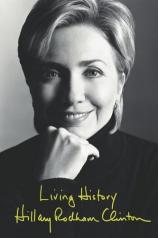Living History
Review
Living History
I have been trying to avoid all the press surrounding the release
of Hillary Clinton's autobiography, LIVING HISTORY. Yet it is
difficult to ignore those who are ranking it this summer's second
greatest piece of fiction (right behind the fifth installment of
the Harry Potter series). Let's face it: ever since Senator Clinton
initially hit the national scene as First Lady, she has been a
controversial and divisive figure. Public opinion of the good
Senator has always been divided --- one loves her or hates her.
Those in the latter category have labeled LIVING HISTORY a
misrepresentation of the truth at the very least, and total
fabrication at worst.
Putting aside the fiction/non-fiction debate for the moment, here
is one reader's advice on LIVING HISTORY: read it and form your own
opinion. I finished the book with a newfound respect for Senator
Clinton --- the individual, the politician, the lawyer, the
woman.
LIVING HISTORY is Senator Clinton's journey from middle-class
American suburbia to the White House. A child of moderate
privilege, she reminisces about growing up in the nurturing 50s
… "my immediate world seemed safe and stable. I didn't know a
child whose parents were divorced, and until I went to High School,
I didn't know anybody who died of anything except old age. I
recognize that this benign cocoon was an illusion, but it is one I
would wish for every child." It is this sentiment, and the story of
her mother's neglectful upbringing, that reminds the reader of one
of her greatest passions and drives --- the welfare of children. In
law school she chose to concentrate on how the law affected
children. She wrote, "I realized that what I wanted to do with the
law was to give voice to children who were not being heard." In all
the muddle that was Monica Lewinsky and Whitewater (and other
scandals that would come later), the American people lost sight of
Senator Clinton's personal vocation, and her successes defending
children and their rights. Successes, I might add, that led to an
earlier book of some note, IT TAKES A VILLAGE.
It was also in law school that she met Bill Clinton, "a force of
nature" as she called him. She fell desperately in love with him,
and he asked her to marry him very early on. As much as she wanted
to entwine her life with his, she felt a responsibility to herself
to continue the work she had started, at least for a time. There is
the theme throughout the book of Senator Clinton needing to stand
on her own as an educated, bright, and committed woman. She took a
position with Marian Wright Edelman at the Children's Defense Fund.
Her work was satisfying and compelling, but equally compelling was
the call of love. She describes her relationship with Bill Clinton
eloquently when she writes, "What can I say to explain a love that
has persisted for decades and has grown through our shared
experiences of parenting a daughter, burying our parents, and
tending our extended families, a lifetime's worth of friends, a
common faith and an abiding commitment to our country?"
Senator Clinton maintains a sense of humor throughout the book (and
one would imagine throughout her life). She writes that "there is
no training manual for First Ladies." And she fills those passages
on her years in the White House with stories about her position as
a media target, whether over her appointment to lead health care
reform or her famous ever-changing hairstyle. She often alludes to
those who came before her in the White House, to illustrate both
the differences and the similarities in the presidential families,
and to argue that she is not the first strong, independent woman to
support her husband in the Oval Office. She points to John and
Abigail Adams as a couple who relied on each other as partners in
life and politics. She gives us Bess Truman, a dedicated editor of
Harry Truman's papers and speeches, as an example of a woman who
played a strong part in her husband's leadership. And then there
was Edith Wilson and the "unofficial presidency" she ran after
Woodrow's stroke. Like many past First Ladies and their husbands,
the Clintons had a relationship, she tells us, based on love and
respect. That love and respect fell under scrutiny on many
occasions, but she maintains that the bond was strong and
unbreakable, no matter what the circumstances.
There are no great revelations in LIVING HISTORY. Senator Clinton
maintains her innocence in the Whitewater accusations and her
incredulity at Bill's admission of infidelity. And it is in these
comments, I believe, where the fiction/non-fiction argument comes
into play. Many ask how she could not have known about Bill and
Monica, Bill and Gennifer Flowers, Bill and Paula Jones, Bill and
… (fill in the blank). But as Senator Clinton states, that is
between her and the former president. Living "history" in the
public eye is not easy and, if nothing else, LIVING HISTORY is a
reminder of that. It is also a testimony to the strength of Mrs.
Clinton as a wife and a citizen, as well as the personal
contributions she has made and will continue to make to the
government and society.
Reviewed by Roberta O'Hara on January 22, 2011
Living History
- Publication Date: November 30, -0001
- Genres: Autobiography, Nonfiction
- Hardcover: 562 pages
- Publisher: Simon & Schuster
- ISBN-10: 0743222245
- ISBN-13: 9780743222242





